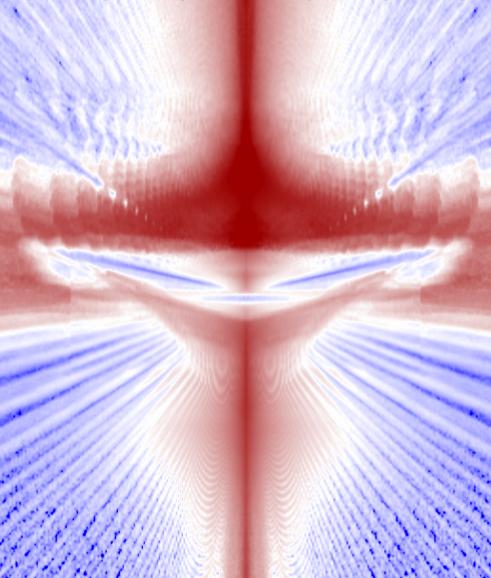
Credit: The University of Manchester
An international research team led by The University of Manchester has revealed a nanomaterial that mirrors the “magic angle” effect originally found in a complex man-made structure known as twisted bilayer graphene – a key area of study in physics in recent years.
The new research shows that the special topology of rhombohedral graphite effectively provides an inbuilt “twist” and therefore offers an alternative medium to study potentially game-changing effects like superconductivity. “It is an interesting alternative to highly popular studies of magic-angle graphene” said graphene pioneer Professor Sir Andre Geim, a co-author of the study.
The team, led by Artem Mishchenko, Professor of Condensed Matter Physics at The University of Manchester published its findings in the journal Nature on 12 August 2020.
“Rhombohedral graphite can help to better understand materials in which strong electronic correlations are important – such as heavy-fermion compounds and high-temperature superconductors”, said Professor Mishchenko.
A previous step-forward in two-dimensional materials research was the curious behaviour that stacking one sheet of graphene atop one another and twisting it to a ‘magic angle’ changed the bilayer’s properties, turning it into a superconductor.
Professor Mishchenko and his colleagues have now observed the emergence of strong electron-electron interactions in a weakly stable rhombohedral form of graphite – the form in which graphene layers stack slightly differently compared to stable hexagonal form.
Interactions in twisted bilayer graphene are exceptionally sensitive to the twist angle. Tiny deviations of about 0.1 degree from the exact magic angle strongly supress interactions. It is extremely difficult to make devices with the required accuracy and, especially, find sufficiently uniform ones to study the exciting physics involved. The newly published findings on rhombohedral graphite has now opened an alternative route to accurately making superconductor devices.
Graphite, a carbon material made up of stacked graphene layers, has two stable forms: hexagonal and rhombohedral. The former is more stable, and has thus been extensively studied, while the latter is less so.
To better understand the new result, it is important to remember that the graphene layers are stacked in different ways in these two forms of graphite. Hexagonal graphite (the form of carbon found in pencil lead) is composed of graphene layers orderly stacked on top of each other. The metastable rhombohedral form has a slightly different stacking order, and this slight difference leads to a drastic change in its electronic spectrum.
Previous theoretical studies have pointed to the existence of all kinds of many-body physics in the surface states of rhombohedral graphite – including high-temperature magnetic ordering and superconductivity. These predictions could not be verified, however, since electron transport measurements on the material were completely lacking until now.
The Manchester team has been studying hexagonal graphite films for several years and have developed advanced technologies to produce high-quality samples. One of their techniques involves encapsulating the films with an atomically-flat insulator, hexagonal boron nitride (hBN), which serves to preserve the high electronic quality in the resulting hBN/hexagonal graphite/hBN heterostructures. In their new experiments on rhombohedral graphite, the researchers modified their technology to preserve the fragile stacking order of this less stable form of graphite.
The researchers imaged their samples, which contained up to 50 layers of graphene, using Raman spectroscopy to confirm that the stacking order in the material remained intact and that it was of high quality. They then measured electronic transport properties of their samples in the traditional way – by recording the resistance of the material as they changed the temperature and the strength of a magnetic field applied to it.
The energy gap can also be opened in the surface states of rhombohedral graphite by applying an electric field explains Professor Mishchenko: “The surface-state gap opening, which was predicted theoretically, is also an independent confirmation of the rhombohedral nature of the samples, since such a phenomenon is forbidden in hexagonal graphite.”
In rhombohedral graphite thinner than 4nm, a band gap is present even without applying an external electric field. The researchers say they are as yet unsure of the exact nature of this spontaneous gap opening (which occurs at the “charge neutrality”- the point at which densities of electrons and holes are balanced), but they are busy working on answering this question.
“From our experiments in the quantum Hall regime, we see that the gap is of a quantum spin Hall nature, but we do not know whether the spontaneous gap opening at the charge neutrality is of the same origin,” adds Professor Mishchenko. “In our case, this gap opening was accompanied by hysteretic behaviour of the material’s resistance as a function of applied electric or magnetic fields. This hysteresis (in which the resistance change lags behind the applied fields) implies that there are different electronic gapped phases separated into domains – and these are typical of strongly correlated materials.”
Further investigation of rhombohedral graphite could shed more light on the origin of many-body phenomena in strongly correlated materials such as heavy-fermion compounds and high-temperature superconductors, to name but two examples.
###
Media Contact
Ben Robinson
[email protected]
Related Journal Article
http://dx.




